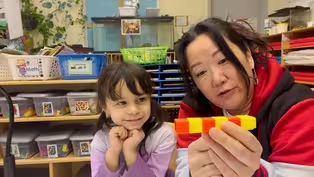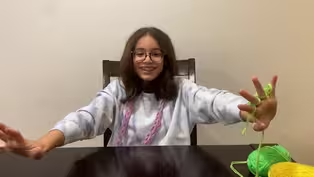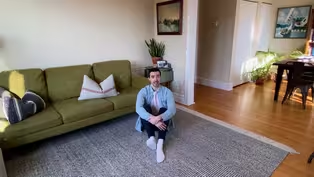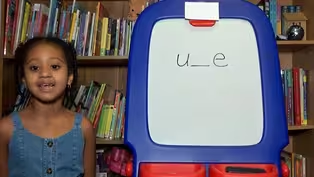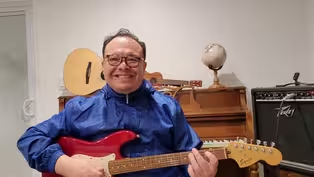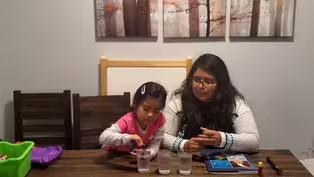
ANIMALS AND LIGHT
Clip: 5/5/2023 | 8m 59sVideo has Audio Description, Closed Captions
Devon Ritter from the Memphis Zoo explores the relationship animals have to light.
Devon Ritter from the Memphis Zoo explores the relationship animals have to light. She explains how nocturnal animals – like a porcupine – depend on senses other than sight to navigate in the dark. She discusses how animals absorb sunlight for energy, and how sunlight helps create the food animals eat. Devon also introduces bioluminescent animals, like fireflies, that make their own light.
See all videos with Audio DescriptionADProblems playing video? | Closed Captioning Feedback
Problems playing video? | Closed Captioning Feedback
Let's Learn is a local public television program presented by THIRTEEN PBS

ANIMALS AND LIGHT
Clip: 5/5/2023 | 8m 59sVideo has Audio Description, Closed Captions
Devon Ritter from the Memphis Zoo explores the relationship animals have to light. She explains how nocturnal animals – like a porcupine – depend on senses other than sight to navigate in the dark. She discusses how animals absorb sunlight for energy, and how sunlight helps create the food animals eat. Devon also introduces bioluminescent animals, like fireflies, that make their own light.
See all videos with Audio DescriptionADProblems playing video? | Closed Captioning Feedback
How to Watch Let's Learn
Let's Learn is available to stream on pbs.org and the free PBS App, available on iPhone, Apple TV, Android TV, Android smartphones, Amazon Fire TV, Amazon Fire Tablet, Roku, Samsung Smart TV, and Vizio.
Providing Support for PBS.org
Learn Moreabout PBS online sponsorship[upbeat music] - Hi everyone, and welcome to the Memphis Zoo here in Memphis, Tennessee.
My name is Devon and I'm an animal interpreter here at the zoo.
I have a very special job because I get to work both with the animals at the zoo and with people all across the world and just like you.
Now, you may be wondering, Devon, why are you holding a flashlight in the dark?
Is this a scary episode?
I promise it's not.
But today we're talking all about light and why it's so important for people and for animals.
Now, let's learn what light is.
Light is a form of energy, and energy is how something changes or moves.
Can you think of something that gives off light?
That's a great answer.
Light can come from many different sources like the sun, like from artificial lights, like lamps and flashlights, and even some animals and plants can make light like fireflies or jellyfish.
All life requires light.
We need light in order to see.
We need light to grow the plants that become our food and shelter for animals.
And we need light in order to make our bodies healthy and strong.
Animals use light in all of these ways and more.
Let's meet a few animals and find out how they use light.
We're here in the nocturnal building, and as you might have noticed, there's not very much light.
Good thing I brought my own.
The reason there's very little light in the nocturnal building is because all of the animals that live here like to be asleep during the day and they're awake at night.
But how does an animal that lives in the darkness find their way around?
Quick, I want everybody to close their eyes.
Now, with your eyes closed, can you smell anything?
Hmm, can you hear anything?
And can you feel anything around you?
Great job, just like you did, animals that live in the dark may have to use their other senses to navigate.
Nocturnal animals have adapted to seeing even in the dark.
That's because there is often still just a little bit of light, even when the sun goes down.
This light often comes from the moon and stars, which reflect the light from the sun.
Nighttime animals have to adjust to having very little light, so their eyes will work differently than ours do.
Owls, wolves, opossums, and many more nocturnal animals have eyes specifically adapted for night vision.
Night vision isn't the same as vision with lighting.
And colors are often harder to make out in the dark.
Nocturnal animals often have very large eyes to help them see in the low light.
They also tend to have larger pupils, which is the dark spot in the center of the eye.
This helps their eyes capture the small amount of light in the environment.
If there was no light at all, animals couldn't see anything no matter how good their eyes were.
Some animals that live where there is little to no light, like cave animals or animals that live in the deep sea, don't have any eyes at all.
They have to adapt to rely on their other senses to navigate their environments.
Now, let's meet an animal that has good night vision.
This is Willa.
And Willa is a prehensile-tailed porcupine.
And she's normally what we would call a nocturnal animal.
Nocturnal animals are typically awake at night and asleep during the day, but Willa is a little different, and that's because she's a special type of animal called an animal ambassador, which means that Willa is specially trained to come out and do programs to meet guests.
So she has to be able to work during the day.
So prehensile-tailed porcupines like Willa are native to South America to live in the trees with their families.
Now we said Willa is a prehensile-tailed porcupine.
That's a pretty fancy word, but prehensile tail is talking about this long tail she has.
And prehensile is a word that means hand-like.
So what she does is she can use this tail to live in the trees, and she's able to grasp things.
It helps her mostly to balance.
So Willa's eyes are much better at seeing in the dark than mine, but she can still have some difficulty with the low light.
So Willa uses her other senses to help her find her food and her friends.
Willa here is very good at recognizing her friends at the zoo.
Nocturnal porcupines like Willa may not get much sunlight, but they still require the light in order to make their favorite food and also the homes they live in, the trees.
Willa's favorite foods are sweet potatoes and corn.
All plants need sunlight to grow.
This means that all the fruits and the vegetables that we and other animals like to eat require light.
Not only do animals rely on plants for food, but they also need them for shelter.
Trees are homes to many animals, and like other plants, they require sunlight.
Without sunlight, animals would not have food to eat or places to live.
So we met Willa, the prehensile-tailed porcupine.
And now, let's meet Pickles, the prehensile-tailed skink.
Now, they both may have prehensile tail in their name, but they're not related.
Can you remember what prehensile means?
That's right.
It's a body part that helps an animal to grab.
Both Pickles and Willa use their prehensile tail to help them navigate through their favorite place to live, the trees.
Trees are homes to many animals like insects, birds, mammals, amphibians, and reptiles, like Pickles.
Trees provide food and shelter and are a key part of many environments.
Some animals make their homes in the base of trees while others roost in the branches.
And some even find ways to live inside the tree.
Trees can often produce fruits, nuts, and leaves to become food for a wide variety of animals.
Many of our favorite foods come from trees like apples, coconuts, lemons, bananas, almonds, and cashews.
Pickles likes to eat a wide variety of fruits and vegetables, but his favorite food are his fruits, like kiwis.
What are your favorite fruits to eat?
Not only does Pickles need light to make his home and his favorite food to eat, he also needs light to help make his body healthy and strong.
Reptiles need to use energy from the sunlight in order to move properly.
Reptiles like Pickles use the light to make vitamin D to make their bodies healthy and strong.
Did you know that we also need vitamin D from the sun?
Certain types of light help our bodies stay healthy.
The sun makes vitamin D, which helps our bones and our immune systems grow strong.
But remember, too much sun can be bad for our skin, so it's important to always wear sunscreen.
Many animals need light from the sun in order to have bodies that work properly.
Cold-blooded animals like snakes, turtles, and fish can't make their own energy, and so they need the heat from the sun.
That heat is converted into energy that the animal can then use to hunt for food, find shelter, and more.
If a cold-blooded animal doesn't get enough heat, their bodies have to slow down to save energy.
We've mostly been talking about light from the sun today, but can you remember, are there some animals or plants that can make their own light?
That's right, there are!
There are certain types of plants and animals that produce their own light, which is called bioluminescence.
Now that may seem like a really big word, but if we break it down, it actually makes a lot of sense.
Bio means life or something living.
And luminescence is just a fancy word for light.
So bioluminescent animals can emit their own light.
Fireflies, mushrooms, algae, jellyfish, and many deep sea fish can all produce light.
They do this for many different reasons.
Some, like fireflies glow to attract other fireflies.
But how do these animals make light?
Some animals glow because of the food they eat, but some animals can make the light by creating a chemical reaction inside their bodies.
Have you ever used a glow stick before?
It doesn't glow until you shake it.
That's because there are two chemicals inside that have to be mixed together in order to make it glow.
A very similar thing happens inside the bodies of some bioluminescent animals.
All right, my friends, today we learned all about light and why it's so important for life.
Can you remember all of the ways that we and animals use light?
Light makes it possible for animals to see.
Light makes it possible for plants to grow, and those plants become food or habitat for animals.
And light also helps animals have healthy bodies by providing them important vitamins.
We also learned that some plants and animals can make their own light with bioluminescence.
All right, my friends.
Well, thank you so much for learning with me today.
From me, Willa the porcupine, Pickles the skink, and all of us here at the Memphis Zoo.
I hope you have a great rest of your day.
Bye, everyone!
Video has Audio Description, Closed Captions
Clip: 5/5/2023 | 5m 57s | Zoe Kleinmann and a student make a pattern of light with translucent cups. (5m 57s)
DAHLIA SHOWS HOW TO FINGER KNIT!
Video has Audio Description, Closed Captions
Clip: 5/5/2023 | 1m 19s | Dahlia shows how to finger knit. (1m 19s)
Video has Audio Description, Closed Captions
Clip: 5/5/2023 | 10m 56s | Aaron Umsted prompts children to tap their feet up and down like a light switch. (10m 56s)
Video has Audio Description, Closed Captions
Clip: 5/5/2023 | 8m 18s | Anna Scretching-Cole explores the long u vowel sound. (8m 18s)
Video has Audio Description, Closed Captions
Clip: 5/5/2023 | 9m 43s | David Martinez prompts viewers to sing loudly and softly using colored lights. (9m 43s)
Video has Audio Description, Closed Captions
Clip: 5/5/2023 | 11m 8s | With her daughter Katherine Rodriguez reads A RAY OF LIGHT by Walter Wick. (11m 8s)
Providing Support for PBS.org
Learn Moreabout PBS online sponsorshipSupport for PBS provided by:
Let's Learn is a local public television program presented by THIRTEEN PBS
